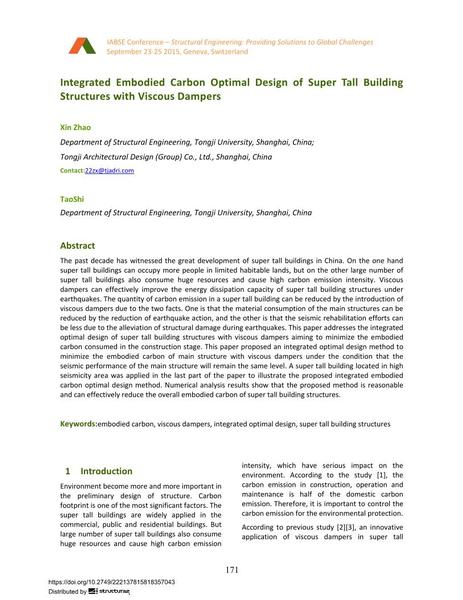Integrated Embodied Carbon Optimal Design of Super Tall Building Structures with Viscous Dampers

|
|
|||||||||||
Bibliografische Angaben
| Autor(en): |
Xin Zhao
(Department of Structural Engineering, Tongji University, Shanghai, China; Tongji Architectural Design (Group) Co., Ltd., Shanghai, China)
Tao Shi (Department of Structural Engineering, Tongji University, Shanghai, China) |
||||
|---|---|---|---|---|---|
| Medium: | Tagungsbeitrag | ||||
| Sprache(n): | Englisch | ||||
| Tagung: | IABSE Conference: Structural Engineering: Providing Solutions to Global Challenges, Geneva, Switzerland, September 2015 | ||||
| Veröffentlicht in: | IABSE Conference Geneva 2015 | ||||
|
|||||
| Seite(n): | 171-177 | ||||
| Anzahl der Seiten (im PDF): | 7 | ||||
| Jahr: | 2015 | ||||
| DOI: | 10.2749/222137815818357043 | ||||
| Abstrakt: |
The past decade has witnessed the great development of super tall buildings in China. On the one hand super tall buildings can occupy more people in limited habitable lands, but on the other large number of super tall buildings also consume huge resources and cause high carbon emission intensity. Viscous dampers can effectively improve the energy dissipation capacity of super tall building structures under earthquakes. The quantity of carbon emission in a super tall building can be reduced by the introduction of viscous dampers due to the two facts. One is that the material consumption of the main structures can be reduced by the reduction of earthquake action, and the other is that the seismic rehabilitation efforts can be less due to the alleviation of structural damage during earthquakes. This paper addresses the integrated optimal design of super tall building structures with viscous dampers aiming to minimize the embodied carbon consumed in the construction stage. This paper proposed an integrated optimal design method to minimize the embodied carbon of main structure with viscous dampers under the condition that the seismic performance of the main structure will remain the same level. A super tall building located in high seismicity area was applied in the last part of the paper to illustrate the proposed integrated embodied carbon optimal design method. Numerical analysis results show that the proposed method is reasonable and can effectively reduce the overall embodied carbon of super tall building structures. |
||||
